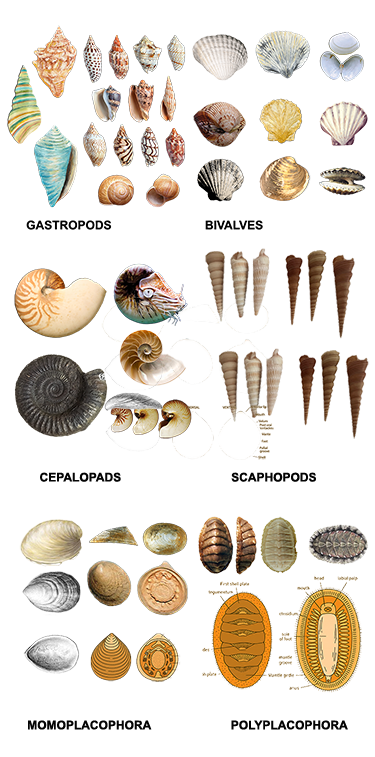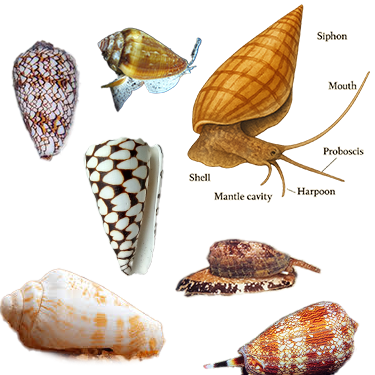
Shells are among nature’s most beautiful and functional creations. They’re not just beach treasures; they are homes, defenses, artworks, fossils, and even climate indicators. Created by marine animals over time, each shell tells a story about the environment and the life it once protected. These shells are found in various shapes, sizes, and colors, belonging to different classes of mollusks. Conchologists, scientists who study shells, place shells into seven classes. Gastropoda - gastropods (snails, whelks, cowries, etc.), Bivalvia - bivalves (cockles, clams, scallops, etc.), ** Scaphopoda (tusk shells), **Aplacophora (worm-like mollusks), Polyplacophora (chitons), Monoplacophora *(cap-like shells bearing one plate) and *Cephalopoda (nautiluses, octopuses, squids etc). Each of these classes is further subdivided into species. Most seashells fall into the category of gastropods and bivalves.
Activity 1 – What are shells?

A shell is a rigid external covering made by animals, mainly mollusks, which include snails, clams, oysters, and some cephalopods. While bones support the body from the inside, shells do the opposite: they’re external structures that act as armor, shielding the soft and vulnerable body within.
Shells are made from calcium carbonate, produced by the animal and secreted through a tissue called the mantle. The shell grows over time, expanding outward in rings or spirals as the animal matures. Many shells feature vibrant colors and patterns, which may act as camouflage or warning signals.
Shells are not only used for protection. Some species, such as scallops, allow mobility by snapping shut and propelling themselves through water. Others, like burrowing clams, use the shell’s shape to anchor in the sand and resist waves or predators.
Have you ever picked up a shell and imagined the life it once protected?
Activity 2 – How Are Shells Made?

Have you ever wondered how a shell gets its shape, shine, or strength? The answer lies inside the animal that makes it. Shells are built by a special part of the mollusk’s body called the mantle — a thin, soft layer of tissue under the shell. The mantle takes calcium and other minerals from the water and slowly builds the shell from the inside out. It adds material layer by layer, like a 3D printer! There are two main ingredients: • Calcium carbonate makes the shell hard. • Proteins and pigments help hold it together and give it color. As the animal grows, the shell grows with it, mainly expanding at the opening. That’s why you often see rings, spirals, or patterns outside of shells: they show the animal’s growth over time. If you could grow your protective shell, what would it look like: smooth, shiny, or strong and spiky? Why?
Activity 3 – Types of Shells

Gastropods: These are characterized by classic spiral shells, such as snails, whelks, and conchs. Some are tiny and delicate, others huge and heavy. Their twisty shapes are not only attractive, but they also help balance and protect. You’ve probably seen one on the beach or in your pasta dish!
Bivalves: These are shells of clams, mussels, oysters, and scallops. They have two matching halves that open and close like a book. Some live buried in sand; others attach to rocks. Shells can be small to medium in size and have many different patterns and colors.
Cephalopods: Most cephalopods, like squids and octopuses, don’t have shells anymore, but the nautilus still does. Its shell is a perfect spiral with internal chambers that help it float. The animal lives in the largest chambers, and the other interior chambers serve as ballast tanks. It’s like a living submarine with tentacles! Its spiral holds the magic of the Golden Rectangle.
Scaphopods (Tusk Shells): These deep-sea mollusks have long, curved shells shaped like tiny tusks. They live buried in ocean mud and feed on microscopic organisms using thread-like tentacles. Though small and rarely seen, they’re fascinating and well-adapted to life in the deep sea.
Monoplacophora: These rare mollusks have simple, rounded shells that look like limpet caps. Once believed extinct, they were found alive in deep-sea trenches. Unusually, they have repeating internal organs ( like multiple pairs of gills and kidneys ) arranged in a row, which gives scientists clues about mollusk adaptation over time.
Polyplacophora (Chitons): Chitons wear armor made of eight overlapping plates along their back. They cling tightly to rocks in rough coastal waters and feed on algae using a scraping tongue. Their shells are strong, flexible, and perfect for surviving wave-pounded shores.
Activity 4 – What Shells Tell Us About the Ocean

Shells aren’t just leftovers from sea animals; they hold clues about the ocean’s past. When a shell forms, it absorbs chemicals from the seawater. Scientists can study these chemicals, especially the oxygen in the shell, to figure out how warm the ocean was thousands of years ago. It’s like reading nature’s notebook. But shells don’t stop being useful after the animal dies. Empty shells often become homes for tiny sea creatures, such as algae, sponges, crabs, or small fish. Some shells even help build coral reefs, adding strength to underwater habitats. Sadly, ocean conditions are changing. With climate change and pollution, the ocean is becoming more acidic. This makes it difficult for animals to build strong shells. In cold places like the Arctic, some young snails and clams can’t grow proper shells at all. Their survival is at risk, and so is the health of the entire ocean system.
What can we do to protect these small creatures that play such a significant role in the ocean’s story?
Activity 5 – Classifying Shells with a Dichotomous Key

Imagine you have a table full of different shells, some spiky, some smooth, some one, some two pieces. How do scientists determine which shell each is? They use a dichotomous key, a step-by-step tool that helps identify species based on physical traits. At the Queensland Museum, scientists study real shell specimens from all over the Indo-Pacific region. Many shells come from gastropods (one-piece spiral shells like snails and cowries) and bivalves (two-part shells like clams and scallops). Using a dichotomous key, they answer questions like:
• Does the shell have spikes?
• Is the shell lined with teeth?
• Are there ridges or ribs on the outside?
• Is the inner surface pearly?
By following these clues, you can narrow down the shell’s identity. Maybe it’s a Tiger Cowry, a Fluted Giant Clam, or even a Spotted Aur. This technique isn’t just for museums. Marine biologists, park rangers, and students use it to understand biodiversity and discover new species!
Try using a dichotomous key to classify some of your shells.
Activity 6 – Deadly Beauty (The Cone Snail).

Shells may seem peaceful, but some of them hide mighty hunters. Meet the cone snail, one of the most dangerous mollusks in the ocean. Cone snails are stunning, with beautiful patterns like zigzags, dots, and marble swirls. But behind that beauty is a deadly secret. Cone snails have a venomous tooth that they shoot into prey, worms, mollusks, and small fish. Once hit, the prey is quickly paralyzed. Some species, like the Geography Cone, are lethal to humans. One person died from its sting on the Great Barrier Reef back in 1935. Today, scientists take special care when studying cone snails. Their venom is also being researched for new pain-relief medicines.
Classification is not just academic; it can be a matter of safety and science. Would you trust yourself to tell a harmless cone snail from a deadly one?
Review
- What are shells mainly made from?
- What part of a mollusk builds its shell?
- What type of mollusk has a shell with internal chambers that help it float?
- What makes it hard for animals to build strong shells today?
- What tool do scientists use to identify shells based on physical traits?
- What makes cone snails dangerous



















































